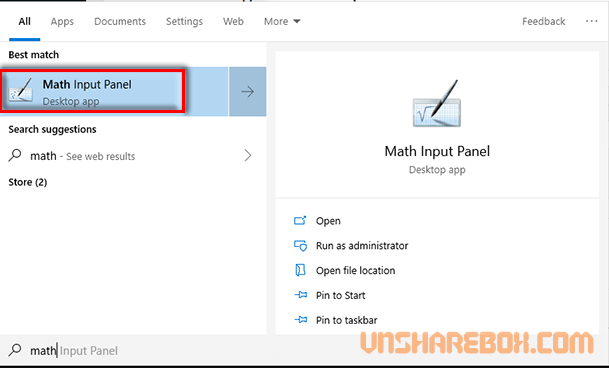
How to use microsoft math input panel windows 10#
For example, you can open the OneNote or Sticky Notes applications included with Windows 10 and write directly in a note to take handwritten notes. Some applications support direct pen input.
How to use microsoft math input panel how to#
RELATED: How to Use Sticky Notes on Windows 10 When you’re using a tablet device with no physical keyboard attached and you’re in desktop mode (not “tablet mode”), Windows will automatically open the handwriting panel. You’ll find a few options for configuring how your pen works at Settings > Devices > Pen & Windows Ink.įor example, the “Show the handwriting panel when note in tablet mode and there’s no keyboard attached” option makes it easier to access the handwriting input panel on tablets with a stylus. RELATED: How to Configure Your Pen and Its Buttons on Windows 10 You can tap in the text field with your stylus to re-position the cursor or select text. If you need to erase the previous word or a few letters, tap the backspace button at the right side of the panel. If Windows doesn’t automatically detect the word you’re writing, tap it on the suggestion bar. Windows should automatically detect the correct word if your handwriting is clear. Just write a word, tap the “Space” or “Enter” button on the panel, write the next word, and continue. Tap the space button on the right side of the panel with your stylus and Windows will enter the word into the text field you have focused. Windows will automatically detect the word you’re writing. With the text field focused, write a word on the handwriting panel with your pen. For example, we’ll be using Notepad here, but you can do this in any traditional desktop program or new Windows 10 app. You can input text in any application with a text input field. You’ll need to tap the keyboard button at the bottom of the touch input keyboard to select the default touch keyboard if you want to use it.

Once you switch to the handwriting input panel, it will automatically appear whenever you tap or click the keyboard icon on your taskbar. Touch the title bar of the panel with your stylus or finger to drag it around your screen and position it wherever you want it. To shrink it, tap the “Undock” button to the left of the “x” on the top right corner of the panel.


By default, it spans the entire width of your display. To learn more about any of these features, refer to our previous blog post on Microsoft Forms.Tap the handwriting keyboard icon, which looks like a pen over an empty panel. Then continue adding the remaining questions to your quiz and share it with your students. Finish the question by adding points, answer feedback and toggling the required field on/off. Tip: If you want an answer to be text instead of an equation, click the ABC icon to change it back to text.Ĩ. If you have chosen a ‘Choice’ style question, click in each of the answer boxes and enter an equation using the calculator. Click OK when you are done.ĭid you know you can easily add maths equations to a Microsoft Form? Learn how in this post! Click To Tweetħ. Click in the Enter an equation box and use the calculator to enter the equation. Enter some text in the question box (e.g. Click the button with the three dots in the bottom right corner of the question box and select Math.ĥ. Add a new question with the type ‘Choice’ (multiple choice or checkbox answers) or ‘Text’ (free text response).Ĥ. If you need help with this step, check out our post on creating self-grading quizzes in Microsoft Forms.ģ.

Choose the New Quiz option to create a new Microsoft Forms quiz. Visit and sign in with your Office 365 Education account.Ģ. In this post, we’ll show you how to use the new feature.ġ. Since then, Microsoft have added the ability to insert maths equations into form questions. In a previous blog post we introduced you to the power of Microsoft Forms for creating self-grading quizzes for students.


 0 kommentar(er)
0 kommentar(er)
